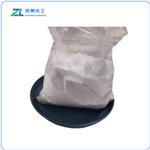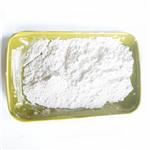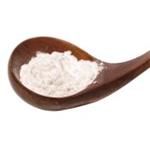Chemical Properties
white granular crystalline powder
Uses
Generally, an increase in butyryl content increases flexibility, moisture
resistance, solubility and compatibility with resins; as the butyryl content
increases, hardness, tensile strength and heat resistance decrease. Cellulose acetate-butyrate injection mouldings
are particularly tough and are used for such applications as tabulator keys
and tool handles; film is employed as a
puncture-resistant packaging material. Cellulose acetate-butyrate is also used
in lacquers for such items as cables, fabrics and furniture and in melt and strip
coatings.
Uses
Contact lens material (hydrophobic).
Cellulose acetate butyrate is the most commonly used organic cel- lulose ester for coating applications.
Preparation
Cellulose acetate-butyrate (CAB) is prepared in a manner similar to that
described previously for cellulose acetate. Esterification is carried out using a
mixture of acetic anhydride and butyric anhydride with sulphuric acid as
catalyst and then the product is slightly hydrolysed. Depending on the
reaction conditions, various products may be obtained; commercial materials
generally have about 1-2 butyryl groups per glucose residue.
Definition
Cellulose acetate butyrate (CAB) is a cellulose ester where the hydroxyl groups attached to the glycoside rings in cellulose are partially or fully substituted by acetyl and butyryl groups. The ratio between acetyl and butyryl substitution can be varied in their synthesis, and somewhat different properties can be obtained. The total degree of substitution (DS) is regarded as a maximum of three; however, for a degree of polymerization (DP) of less than 134, a slightly higher DS can occur due to the end-group contribution. Both the DS and the molecular weight of cellulose esters can be altered, and both are reported to lead to a variation in material properties[1].
Industrial uses
Commonly called butyrate or CAB, it is somewhattougher and has lower moisture absorptionand a higher softening point than acetate.CAB is made by the esterification of cellulosewith acetic acid and butyric acid in the presenseof a catalyst. It is particularly valuedfor coatings, insulating types, varnishes, andlacquers.
Special formulations with good weatheringcharacteristics plus transparency are used foroutdoor applications such as signs, light globes,and lawn sprinklers. Clear sheets of butyrateare available for vacuum-forming applications.Other typical uses include transparent dial covers,television screen shields, tool handles, andtypewriter keys. Extruded pipe is used for electricconduits, pneumatic tubing, and low-pressurewaste lines. Cellulose acetate butyrate alsois used for cable coverings and coatings. It ismore soluble than cellulose acetate and moremiscible with gums. It forms durable and flexiblefilms. A liquid cellulose acetate butyrate isused for glossy lacquers, chemical-resistantfabric coatings, and wire-screen windows. Ittransmits ultraviolet light without yellowing orhazing and is weather-resistant.
Solubility in organics
Chlorinated hydrocarbons, esters, lower molecular weight ketones, nitroparaffins
Advantages
Cellulose Acetate Butyrate, commonly known as CAB, is a thermoplastic material derived from cellulose. It is a clear and amorphous polymer that combines the benefits of cellulose acetate and cellulose butyrate. CAB offers a unique combination of clarity, impact resistance, and chemical resistance, making it a popular choice in various industries. It is commonly used to produce clear and tinted sheets, films, and coatings for eyewear, automotive interior trim, signage, and decorative laminates. CAB is also employed in the manufacturing of consumer goods, including handles, knobs, and other household items, due to its durability, ease of processing, and aesthetic appeal.
References
[1] Malin Nejstr?m. “On Structural and Molecular Order in Cellulose Acetate Butyrate Films.” Polymers 15 9 (2023).



